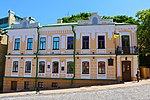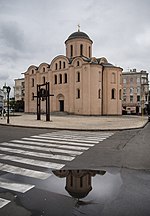Zamkova Hora (Kyiv)

Zamkova Hora hill (Ukrainian: Замкова Гора, literally Castle Hill) in Kyiv, Ukraine is a historical landmark in the center of the city. It is part of the city's geographic relief complex known as Kyiv Mountains (or Kyiv Hills). The place is called "Zamkova" because Vytautas the Great had his castle here. Other names: Khorevytsya, Kyselivka, Frolovska, Lysa Hora. Some important events of Ukrainian history took place on the hill. According to some researchers, Zamkova Hora also has a mystical prehistory, supposedly being one of the lysi hory ("bald mountains") - the sites of the witch gatherings. Geographically, it is really "bald" (lacking trees) from several sides. In the 18th century a cemetery was established on the hill (now abandoned). It is now a small landscape park in Podil Raion still containing interesting grave monuments. Zamkova Hora is also one of two hills that border the Andriyivskyy Descent. Reclaiming the mystical essence of the hill, local satanist groups have conducted their ceremonies there since late 1980s. Small ritual structures were covertly built on site.
Excerpt from the Wikipedia article Zamkova Hora (Kyiv) (License: CC BY-SA 3.0, Authors, Images).Zamkova Hora (Kyiv)
Khoryva Street, Kyiv Podil
Geographical coordinates (GPS) Address Nearby Places Show on map
Geographical coordinates (GPS)
| Latitude | Longitude |
|---|---|
| N 50.4625 ° | E 30.510833333333 ° |
Address
Залишки дороги від колишніх Воєводських воріт
Khoryva Street
04072 Kyiv, Podil
Ukraine
Open on Google Maps











